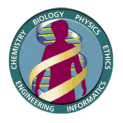|
Basic
Information About
the Project Medicine
& Ethical,
Legal, Education Research
Publications
|
The large, multidisciplinary Human Genome Project (HGP)–the completed effort of finding all human genes and characterizing a reference genome–has promised to revolutionize the future so profoundly that the 21st has been dubbed the "biology century." Almost everyone will be affected by applications of information and technologies derived from the HGP era of the late 20th century. Entirely new approaches will be implemented in biological research and the practice of medicine and agriculture. Genetic data will provide the foundation for research in many biological subdisciplines, leading to an unprecedented understanding of the inner workings of whole biological systems. The benefits of genomic research are, or soon will be, realized in such areas as forensics and identification science, ecology and environmental science, toxic-waste cleanup, creation of new bioenergy sources and more efficient industrial processes, as well as in understanding the mysteries of evolution, anthropology, and human migration. Among the fields that HGP research will impact are engineering, computer science, mathematics, counseling, sociology, ethics, religion, law, agriculture, education, pharmaceuticals, instrumentation, nuclear medicine, forensics, bioremediation, biofuels, and journalism. Cross-disciplinary students with solid backgrounds in science and in one or more other fields such as journalism, law, and computer science will be needed to tackle the issues and applications arising from the HGP. Commercialization of numerous applications in genomic science is fueling the burgeoning life sciences economic sector. Legislation and litigation increasingly will be concerned with genetics and the intellectual-property issues pertaining to genetic information and technologies. Educators, the media, students, and the public need a good understanding of this "new genetics" and its implications so that they can better communicate, teach, and help others make related career and personal decisions. Democratizing access to genetic science information should help maximize HGP benefits while protecting against misuse of the data. Every effort must be made to ensure that everyone–regardless of race, citizenship, or national origin–enjoys the benefits of genomics research and its subsequent applications, including life improvements and excellent career possibilities. Society simultaneously must be protected from such possible negative impacts as the failure to preserve the privacy of individual genetic information. Today, people in fields such as business, which traditionally did not require life sciences training, increasingly are finding that, at the very least, they need a working knowledge of the principles of biology and life science research and development. Presented below are some traditional and new bioscience career possibilities, followed by some educational strategies for pursuing such careers. Possible Career Areas in Bioscience Note: The biotechnology industry has more than tripled in size between 1992 and 2001, with revenue increasing from $8 billion to $27.6 billion. In 2001, there were 191,000 U.S. employees, and more opportunities are expected in healthcare, food production, and environmental cleanup (www.bio.org). In regard to the burgeoning drug industry based on genomics, the Consulting Resources Corporation’s newsletter for biotechnology professionals said, "We expect the growing family of new genomics, proteomics, and bioinformatics technologies to dominate . . . developments in therapeutics by greatly improving the efficiency and speed of the entire drug discovery, testing, and approval process." Medicine
Agriculture and Wildlife
Computational Biology (including Bioinformatics)
Engineering Disciplines
Business
Law and Justice
History and Anthropology
Military
Space Exploration
Bench Science
Bioscience Communication
Preparing for a Career in the Biosciences
More Information on the Web
Career Guidance Publications
HGMIS would appreciate suggestions for more materials for this area.
Send the url of this page to a friend |
Last modified: Tuesday, September 16, 2008
Home * Contacts * Disclaimer
Base URL: www.ornl.gov/hgmis
![]() Site sponsored by the U.S. Department of Energy
Office of Science, Office
of Biological and Environmental Research, Human
Genome Program
Site sponsored by the U.S. Department of Energy
Office of Science, Office
of Biological and Environmental Research, Human
Genome Program

